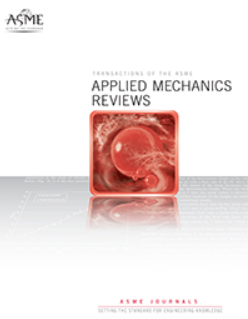Effects of a Torsion Spring Used in a Flexible Delta Tricycle
IF 16.1
1区 工程技术
Q1 MECHANICS
引用次数: 0
Abstract
A new tilting delta tricycle is developed as a last-mile vehicle. This vehicle has a hinge between the front driver module and the rear cargo module to allow the driver to tilt while maneuvering. The driver module resembles a conventional bicycle without a rear wheel and the cargo module consists of a cargo area between two propelled rear wheels. The concept vehicle ensures proper handling qualities independent of the cargo. However, the driver module can still tip over when parked. Multiple solutions are being considered to improve the ergonomics of this vehicle. A metal-elastomer torsion spring with an integrated angle limit has the most advantages as this prevents the driver module from tipping over without requiring it to enable a mechanism while stepping off. Furthermore, the torsion system dampens vibrations while cycling and influences tilting while turning. These improvements are tested using the concept vehicle. The influence of this torsion system is calculated and validated with measurements. The influences of different torsion curves aimed to improve the low-speed stability are calculated.弹性三角三轮车用扭力弹簧的效果
一种新的倾斜三角三轮车被开发作为最后一英里的车辆。这种车辆在前驾驶员模块和后货物模块之间有一个铰链,允许驾驶员在操纵时倾斜。驾驶员模块类似于没有后轮的传统自行车,货物模块由两个推进后轮之间的货物区域组成。概念车确保适当的处理质量独立于货物。然而,驾驶员模块在停车时仍然会翻倒。目前正在考虑多种解决方案来改善这款车的人体工程学。具有集成角度限制的金属弹性体扭转弹簧具有最大的优势,因为它可以防止驱动模块翻倒,而无需在踩下时启用机制。此外,扭转系统在循环时抑制振动,并在转弯时影响倾斜。这些改进正在使用概念车进行测试。计算了该扭转系统的影响,并通过测量进行了验证。计算了不同扭转曲线对提高低速稳定性的影响。
本文章由计算机程序翻译,如有差异,请以英文原文为准。
求助全文
约1分钟内获得全文
求助全文
来源期刊
CiteScore
28.20
自引率
0.70%
发文量
13
审稿时长
>12 weeks
期刊介绍:
Applied Mechanics Reviews (AMR) is an international review journal that serves as a premier venue for dissemination of material across all subdisciplines of applied mechanics and engineering science, including fluid and solid mechanics, heat transfer, dynamics and vibration, and applications.AMR provides an archival repository for state-of-the-art and retrospective survey articles and reviews of research areas and curricular developments. The journal invites commentary on research and education policy in different countries. The journal also invites original tutorial and educational material in applied mechanics targeting non-specialist audiences, including undergraduate and K-12 students.

 求助内容:
求助内容: 应助结果提醒方式:
应助结果提醒方式:


